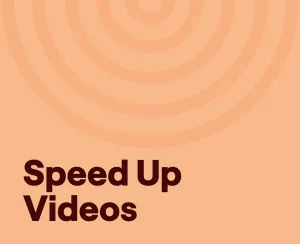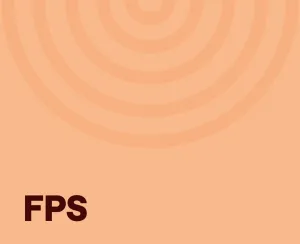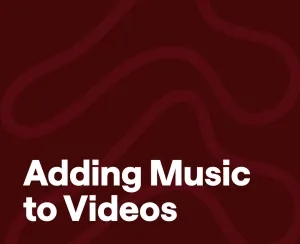It might be hard to imagine, but every big vlogger you know started with zero views, an okay-ish camera, and a wild idea. No fancy setup, no viral magic. Just a person with something to share, the courage to hit “record” and improve with time.
No matter what type of content you create, vlogging is your space to craft, connect, and grow, and if done right, it can even help you generate income. In this beginner’s guide to how to start a vlog, we’ll walk you through the basics, so you can skip the stress and start your vlogging journey with confidence (and a lot of excitement).
Now, if you’re ready, let’s hit record straight away!
Table of Contents
– What is a Vlog?
– Popular Types of Vlogs to Inspire You
– How to Start a Vlog Step-by-Step
– Vlogging Tips for Beginners
– Create a Vlog with Podcastle
What is a Vlog?
A vlog (short for video blog) is exactly what it sounds like: a blog, but in video form.
Instead of writing down your thoughts, you film them. It’s where creators share slices of their lives, ideas, routines, or experiences through the camera lens, turning everyday moments into stories worth following.
At its core, a vlog is storytelling made personal. Whether you're showing how you make your morning coffee, unpacking your latest travel adventure, or offering commentary on a trending topic, vlogging is all about connection. It invites viewers into your world, and that’s what makes it so powerful.
In the early days of YouTube, vlogs were raw and real. We’re talking about grainy footage, minimal editing, and daily uploads from bedrooms or kitchen tables. It was messy, and yet authentic, unfiltered, and refreshingly honest.
Since then, vlogging has certainly come a long way.
Today, most vlogs are a blend of spontaneity and strategy. Sure, they still capture real life, but now they’re often thoughtfully structured, aesthetically shot, and creatively edited. Platforms like Instagram Reels, TikTok, and YouTube Shorts have completely reshaped the way creators vlog, favoring short-form, visually polished content that hooks viewers within the first few seconds.
You’ll now see vlogs that feel more like mini-movies than casual check-ins. Smooth transitions, custom soundtracks, on-screen text, and curated color palettes are all the hype right now. There’s even a rise in “edutainment,” vlogs that mix storytelling with value, like productivity hacks told through a cozy day-in-the-life, or travel tips wrapped in a cinematic road trip montage.
In other words, a vlog can be anything you want it to be:
- A 60-second vertical clip on TikTok
- A moody “Get Ready With Me” on Instagram
- Or a beautifully edited soundless travel diary on YouTube
Whether you're filming with your phone in selfie mode or using a DSLR with a full editing setup, vlogging is all about your voice, your vision, and how you want to share it.
But do you know what the best part is? You don’t need to be an expert to start. Not at all!
Popular Types of Vlogs to Inspire You
So you’re thinking of starting a vlog, but where do you even begin? The beauty of vlogging is that there’s no one-size-fits-all formula. From casual phone clips to stylized masterpieces, the options are wide open.
Let’s look at some of the most popular types of vlogs out there to spark your creativity (and maybe help you find your vlogging style).
Based on platform trends, algorithmic boost, viewer behavior, and niche growth, we’ve found out that the top vlogging types are these:
1. Lifestyle Vlogs
This is the classic, the OG of vlogging. Lifestyle and especially day-in-the-life vlogs are exactly what they sound like: a walk through your day, from that first sleepy sip of coffee to your late-night skincare routine. Viewers love these for the cozy, relatable vibe; they’re like a virtual hangout. You’ll see them everywhere from YouTube to TikTok, often paired with soft music, and just enough real-life chaos to feel authentic. These vlogs don’t need a big story arc, because they are the story.
2. Travel Vlogs
Dreamy drone shots, scenic train rides, food you can practically taste through the screen… travel vlogs are all about bringing viewers along for the ride. They’re popular because they offer both escapism and inspiration, and who doesn’t love a good passport stamp moment?
These vlogs are a feast for the eyes and often the soul. YouTube remains the top spot for travel vlogs due to the longer format of travel vlogs, but TikTok and Instagram Reels are perfect for quick, punchy location highlights.
3. Behind the Scenes Vlogs
There’s something irresistible about getting a peek behind the curtain. BTS vlogs show what goes into creating something, like a music video, a small business launch, or even just prepping for a big day. These are especially popular on YouTube and Instagram Stories, where creators let followers in on the process, the planning, and the inevitable bloopers. It’s not about perfection, it’s about personality and showing the human side of your art.
4. Commentary or Opinion Vlogs
Got thoughts on certain subjects? Of course, you do. Commentary vlogs are where creators speak their minds about pop culture, social trends, books, shows, or just life. These videos can be funny, fiery, or deeply thoughtful, and they tend to build strong communities because viewers stick around for your take, not just your content. They’re huge on YouTube, but TikTok is also filled with mini monologues and hot takes. This vlog style thrives when there’s honesty, a strong voice, the occasional well-timed meme, and unpopular opinions.
5. Food Vlogs
Food vlogs are a feast for both the eyes and the algorithm. Whether it’s a sizzling street food tour, a cozy “What I eat in a day,” or a fast-paced recipe video, food content is irresistibly watchable and shareable. These vlogs thrive on all platforms because they tap into universal cravings, cultural curiosity, and the simple joy of watching something delicious come together. From ASMR-style cooking to chaotic kitchen fails, food vlogs blend entertainment and education in a way that appeals to just about everyone.
How to Start a Vlog Step-by-Step
After choosing the vlog type closest to your heart and vibe, it’s time to get practical! True, starting a vlog is not as difficult as it might sound, but there still might be challenges you will need to overcome. Vlogging is all about taking one small, doable step at a time, and we’ll walk you through every part of the process:
Step 1: Define your purpose and audience
Before your thumb even hovers over the record button, pause and ask yourself: Why am I doing this? Are you here to share travel memories? Boost your small business? Maybe you're hoping to help others by sharing your experiences. Once you understand your “why,” it becomes easier to figure out who you’re speaking to. Are they students? Moms? Freelancers? Your purpose and your target audience shape everything, from what you say to how you say it. Don't worry if it evolves; it often does, and it’s okay.
Use Google Docs or Excel to brainstorm and get all the information down somewhere, so you can always use it as an anchor.
Step 2: Do research in your niche
Once you have the slightest idea of what you’re creating and for whom, it’s time to do competitor research. Spend time watching what’s already out there, not to copy, but to learn and get inspired. What types of vlogs are working in your niche? What’s missing? How do creators in your niche engage their audience? Look at thumbnails, titles, editing styles, and even the vibe of their YouTube intros. Take notes and screenshots to remember. You’ll start to see patterns and possibilities. This step can spark ideas and help you carve out your own corner in the sea of vlogs.
Step 3: Choose your platform and format
Not every vlog belongs on YouTube. Some are made for quick, vertical bursts on TikTok or Instagram Reels, while others need space to breathe in a 10-minute YouTube format. Think about your strengths and the type of content you want to create. Do you love fast, visual storytelling? TikTok might be your spot. Want to talk, reflect, or show full days? YouTube fits better. Pick one platform to start with, master it before jumping to more.
Step 4: Write down a content plan
You don’t need a 12-tab spreadsheet or a branding consultant. Keep it small and realistic. Decide how often you’ll post, what general themes you’ll stick to, and how you’ll keep it manageable with your current schedule. Consider this your content compass; it won’t stop you from exploring, but it keeps you pointed in the right direction.
Step 5: Plan out 5-10 vlog ideas
Don’t wing it every time. Before launching, brainstorm 5 to 10 solid video topics. They don’t need to be groundbreaking: “My Morning Routine,” “Why I Started Freelancing,” or “What I Eat in a Day” all work if they’re authentic. Having a backlog of ideas reduces the stress of “what should I film today?” and helps you stay consistent early on.
Step 6: Hit record
Here’s where the magic (and awkwardness) happens. Your first takes might feel clunky, and that’s normal. Don’t aim for perfect in the beginning; aim for done.
You can write down your script and use cue cards or a good teleprompter to stay on track, and if it doesn’t go as planned, you can always edit it later.
Gone are the days when you could make excuses for not getting yourself out there because you didn’t have a vlogging camera or other means for ideal content.
Luckily, now most phones have the necessary recording capabilities for both high-quality footage and impeccable voiceovers. No need to drop hundreds of dollars on a vlogging camera or a mic. Simply use your phone, find good lighting (natural light works wonders), and record in small chunks so it’s easier to edit later. And if you’re shy on camera, pretend you’re talking to a close friend. You’ll find your voice with practice.
Step 7: Edit with intention
Editing isn’t about fancy effects, it’s about clarity and flow. Cut out pauses, keep the best shots, add captions if your vlog needs them, and throw in music when it complements your vibe. Free editing tools like Podcastle or CapCut are perfect for beginners, making the editing process easier than ever. Once the editing is done, watch your vlog back like a viewer: Does it drag? Does it make sense? That’s how you know it’s ready to be published.
Step 8: Be consistent
Posting once and disappearing won’t make you a vlogger. Commit to a schedule that fits your life, even if it’s just one video every two weeks. Consistency builds trust and trains the algorithm, but more importantly, it trains your audience (and yourself). Keep showing up, and your growth will gradually follow.
Step 9: Track, adjust, improve
Treat your first few videos like experiments. Look at the data YouTube, TikTok, and Instagram offer, check what’s getting views or comments? Where do people drop off? But don’t just chase numbers. Adjust based on what feels good and what works. Maybe people loved your voiceover, or a certain video got shared a lot. Use that feedback loop to improve without losing your original vibe.
Step 10: Build your community
Last, but not least, build a community! A vlog isn’t just content, it’s a connection. Respond to comments, ask your viewers questions, share bits of your personality, maybe even do meaningful giveaways. Over time, this turns passive viewers into a real community. Whether it’s five people or five thousand, show up for them and they’ll show up for you. That’s what makes vlogging feel real and rewarding.
Vlogging Tips for Beginners
With all the information above, vlogging might seem overwhelming, but really, it’s all about having fun and being yourself. These vlogging tips for beginners will help you kick things off the right way and create content you’re proud of.
1. Use What You Have
You don’t need a DSLR or a pro mic to start vlogging. Your phone is more than enough, as long as your audio is clear and you’re in decent lighting. Natural light from a window can make your video look instantly better. For voicovers, even iPhones offer a great audio quality, but if that’s not enough, Podcastle can help you record audio even in the noisiest places.
2. Show, Don’t Just Tell
Vlogging isn’t just talking to the camera. Show moments and aesthetics, what you're cooking, where you’re walking, and how you set up your workspace. Even everyday stuff becomes interesting when you film it thoughtfully. Think like a storyteller: what can you show that adds to what you're saying?
3. Keep Your Videos Snappy
Attention spans online are short. Cut out the fluff. Remove long pauses, unnecessary rambles, or anything that doesn’t serve your story. A good rule of thumb: if you’d skip it while watching someone else’s vlog, cut it from yours, too.
4. Be Yourself, Seriously
Trying to sound like someone else or force a “vlogger voice” will burn you out fast. Talk like you talk. Laugh at your jokes. Be awkward. That’s the stuff people connect with. Authenticity always beats perfection.
5. Plan, But Don’t Overplan
Having a loose idea of what you want to film is helpful. A quick bullet list or a rough outline will keep your vlog focused. But don’t script everything, it’ll make you stiff. Let real moments happen. The beauty of vlogging is in the unexpected.
6. Engage With Your Viewers
Even if you only have a few comments, reply. Ask your viewers questions. Mention them in future videos. It creates a feedback loop and makes your vlog feel like a conversation, not a broadcast. Community is what keeps people coming back.
7. Rewatch and Learn
Watch your vlogs like a viewer. What works? Where did it drag? Were you rambling? How was the audio? You’ll learn so much just by reviewing your work, and each vlog will be better than the last.
8. Don't Obsess Over the Algorithm
Yes, titles, thumbnails, and tags matter, but at the beginning, your focus should be on making better videos and getting comfortable on camera. Growth takes time. Stay consistent, stay creative, and don’t let numbers kill your joy.
9. Back Everything Up
This one’s not glamorous, but it’ll save you tears. Back up your footage and finished videos to a cloud service or an external hard drive. Accidents happen, and lost content is a heartbreak you can avoid.
10. Celebrate Your Progress
Your first vlog won’t be your best, and that’s the point. Every video is a step forward. Celebrate your uploads, your first comments, and your first 100 views. Small wins matter!
Create a Vlog with Podcastle
Vlogging has become much easier over the past couple of years, and that’s partly due to all the smart software and AI tools out there. For instance, creating a vlog with audio and video editor Podcastle is like turning your bedroom into a mini movie studio, minus the expensive gear and confusing setup. With just a few clicks, you’ve got pro-level tools at your fingertips, making it super easy (and so much fun) to bring your ideas to life on camera.
Here’s what you can do on the platform (besides the basic trim, cut, and crop) to create more aesthetic and unique vlogs in no time:
- Enhance Your Video Quality: Automatically sharpen your footage and improve the quality of your vlog with just a click, so your video looks polished, even if you filmed it on a regular webcam.
- Correct Eye Contact: Subtly adjusts your gaze frame-by-frame, so it appears like you’re looking directly into the camera, even if you glance at notes or a screen.
- Remove Background Noise: Use the Magic Dust AI tool to instantly clean up your audio and cut out annoying background sounds like fans, street noise, or keyboard clicks.
- Convert Text-to-Speech and Speech-to-Text: Turn your vlog script into natural-sounding voiceovers or easily transcribe your speech into text for captions, blogs, or subtitles.
- Blur Video Background: Keep the focus on you by softly blurring your background, perfect for when your filming space isn’t exactly “camera-ready.”
- Edit Your Vlogs Faster: Trim, cut, and resize your videos in no time with the help of the simple interface. When we say you don’t need any technical skills to craft vlogs and podcasts, we mean it!
- Add Voiceovers: Record studio-quality voiceovers directly in the editor to add commentary, narration, or that extra personal touch to your vlog. And in case you don’t want to record a voiceover, there are 1000+ natural-sounding AI voices at your fingertips, so you just need to type your text and watch the magic happen within a short minute!
These are just a few of the powerful tools you can explore with Podcastle. Start your journey today and unlock the full potential of effortless, professional-quality vlogging that’s full of creativity
FAQ
What is a video blog?
A video blog, or vlog for short, is basically a blog in video format. Instead of writing about your thoughts, experiences, or interests, you record yourself talking about them, or actually doing them. Vlogs can cover anything, from daily life and travel to tutorials, reviews, or personal stories. People usually upload them to platforms like YouTube or TikTok, where others can watch and engage.
What is the difference between a blog and a vlog?
The main difference is the format. A blog is written, like an online journal or article, while a vlog is recorded as a video. With blogs, people read your content, but with vlogs, they watch and hear you. Both are ways to share ideas or tell stories, but the style and the way people consume them are different.
How much money can you make vlogging on YouTube?
It really depends on your views, audience, and how you monetize. Some vloggers make just a little, while others earn thousands or even millions a year. On average, YouTubers might earn around $2 to $5 per 1,000 views from ads, but many also make money through sponsorships, merch, and affiliate links. So if your channel grows, and you build a loyal audience, it can become a serious source of income.”










